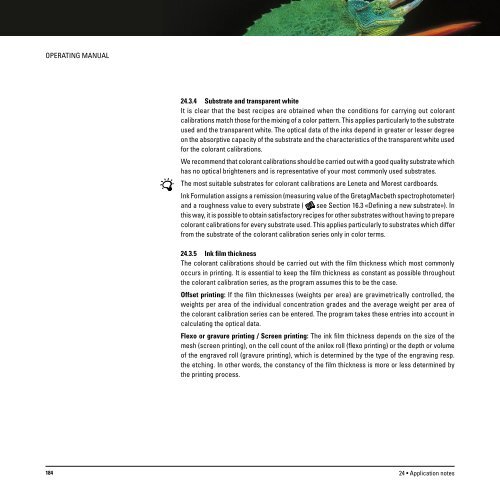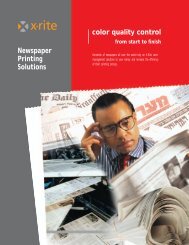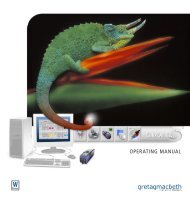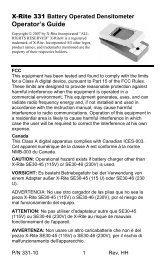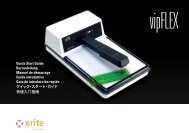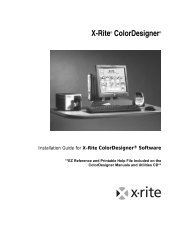Operating Manual
Operating Manual
Operating Manual
You also want an ePaper? Increase the reach of your titles
YUMPU automatically turns print PDFs into web optimized ePapers that Google loves.
OPERATING MANUAL<br />
24.3.4 Substrate and transparent white<br />
It is clear that the best recipes are obtained when the conditions for carrying out colorant<br />
calibrations match those for the mixing of a color pattern. This applies particularly to the substrate<br />
used and the transparent white. The optical data of the inks depend in greater or lesser degree<br />
on the absorptive capacity of the substrate and the characteristics of the transparent white used<br />
for the colorant calibrations.<br />
We recommend that colorant calibrations should be carried out with a good quality substrate which<br />
has no optical brighteners and is representative of your most commonly used substrates.<br />
The most suitable substrates for colorant calibrations are Leneta and Morest cardboards.<br />
Ink Formulation assigns a remission (measuring value of the GretagMacbeth spectrophotometer)<br />
and a roughness value to every substrate ( see Section 16.3 «Defining a new substrate»). In<br />
this way, it is possible to obtain satisfactory recipes for other substrates without having to prepare<br />
colorant calibrations for every substrate used. This applies particularly to substrates which differ<br />
from the substrate of the colorant calibration series only in color terms.<br />
24.3.5 Ink film thickness<br />
The colorant calibrations should be carried out with the film thickness which most commonly<br />
occurs in printing. It is essential to keep the film thickness as constant as possible throughout<br />
the colorant calibration series, as the program assumes this to be the case.<br />
Offset printing: If the film thicknesses (weights per area) are gravimetrically controlled, the<br />
weights per area of the individual concentration grades and the average weight per area of<br />
the colorant calibration series can be entered. The program takes these entries into account in<br />
calculating the optical data.<br />
Flexo or gravure printing / Screen printing: The ink film thickness depends on the size of the<br />
mesh (screen printing), on the cell count of the anilox roll (flexo printing) or the depth or volume<br />
of the engraved roll (gravure printing), which is determined by the type of the engraving resp.<br />
the etching. In other words, the constancy of the film thickness is more or less determined by<br />
the printing process.<br />
184<br />
24 • Application notes


